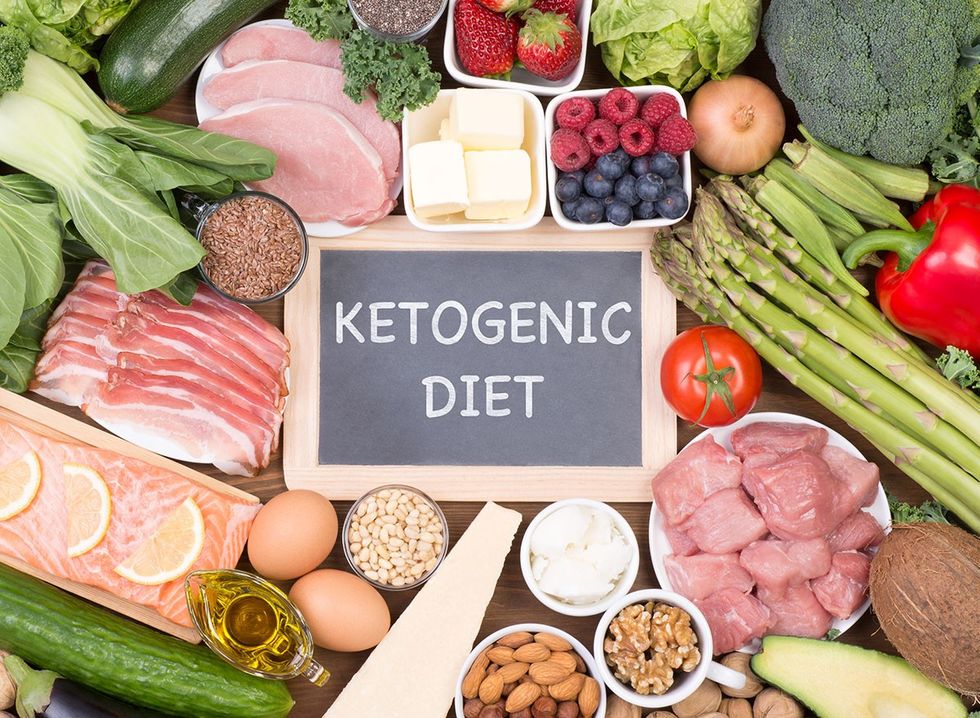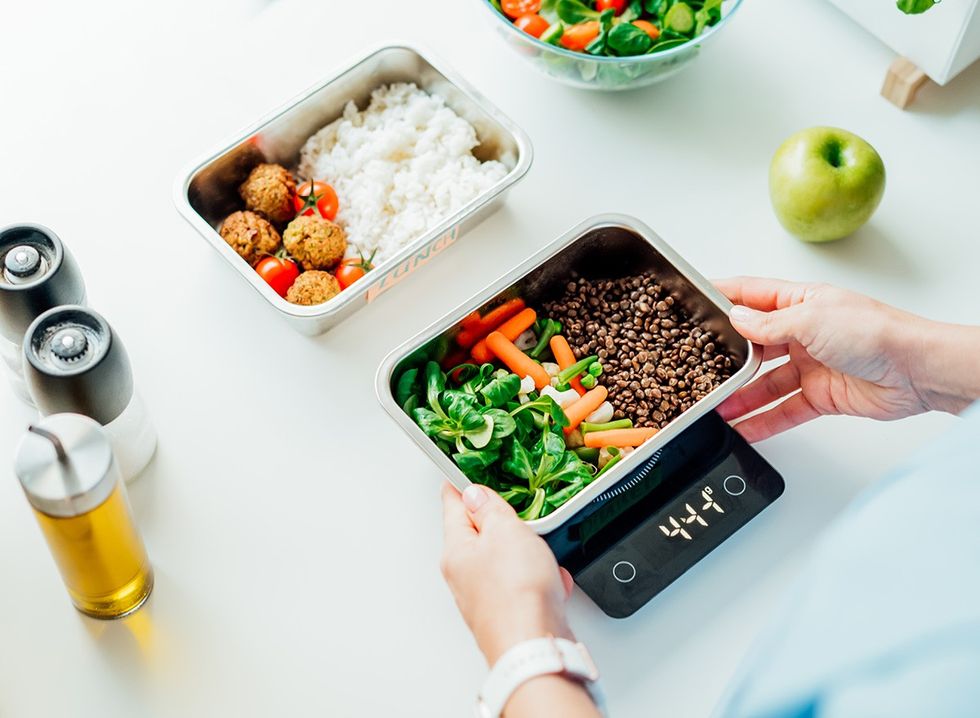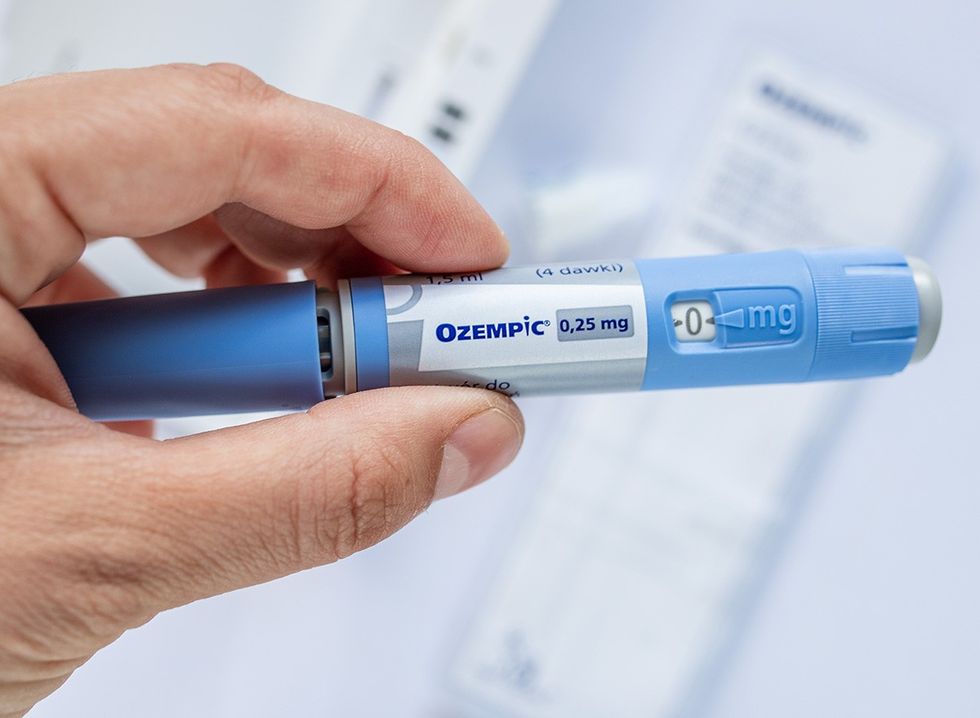Gary Linkov, MD, is double board-certified by the American Academy of Facial Plastic and Reconstructive Surgery and the American Board of Otolaryngology-Head & Neck Surgery. He happens to be married to Liz Grand, MD, a board-certified internal medicine physician. “Ozempic has been all over the news, and social media celebrities and many others have been using it, but of course, they don't admit to it,” he says, introducing his wife to “help me with this topic.” In the interview, she reveals everything you need to know about weight loss drugs.
 Shutterstock
Shutterstock
Dr. Grand explains that Ozempic is the brand name for a medicine called Semaglutide. “It's a once-weekly subcutaneous injectable medication, uh, meaning that the medicine gets injected into the skin, usually in the upper arm, the thigh, or the abdomen,” she says.
It’s Primarily Used to Treat Type 2 Diabetes
“It's primarily used to treat type two diabetes. That's what it was FDA approved for initially in 2017,” she continues. “Ozempic or semaglutide belongs to a class of medications called GLP-1 receptor agonists. GLP-1 is basically a hormone that's produced by the GI tract. And so the GLP one receptor agonists essentially work on these GLP-1 receptors.”
Where Are GLP-1 Receptor Located?
 Shutterstock
Shutterstock
“GLP-1 receptors are located throughout the body, but there are three main areas that we'll talk about today,” Dr. Grand continues. “The first is the pancreas which leads to the release of insulin. Insulin then promotes the absorption of glucose into tissues to be used for energy or to be used as a form of energy storage. And this ultimately causes a decrease in blood glucose levels. The second is the brain, which decreases appetite by reducing the feeling of hunger. And the third is the GI tract, which slows down the movement of food and thus makes us feel fuller.”
What Is the Correct Dosage and How Much Does It Cost?
 Shutterstock
Shutterstock
“In terms of dosing, we generally start with semaglutide at 0.25 milligrams weekly, and it can gradually be increased to a maximum of two milligrams as tolerated. The cost without insurance can be up to about $1,200 a month,” she says.
RELATED: 12 Tips to Maintain Weight Loss After Using Ozempic and GLP-1 Medications
Wegovy Is Another Form of Semaglutide
 Shutterstock
Shutterstock
“There is another form of semaglutide called Wegovy, and this is basically semaglutide in a higher dose,” she says.“This is the medication that's actually FDA-approved for weight loss, but it is specifically approved for people either with obesity or who are overweight with at least one weight-related condition. These include conditions like high blood pressure, high cholesterol, and heart disease.”
Both Ozempic and Semaglutide Reduce Weight
 Shutterstock
Shutterstock
So, what is ozempic or semaglutide used for? “It was initially meant for the treatment of type two diabetes to help decrease blood sugar by augmenting the release of insulin. But people found that there was also this impact on weight loss, and it's been studied and it has been shown to reduce weight,” she says.
However, to Maintain the Weight Loss, You Might Have to Stay on Them
 Shutterstock
Shutterstock
There is one major con about using drugs for weight loss. “They've also found that people generally need to stay on Ozempic in order to maintain the weight loss,” she says.
Risks and Side Effects
 Shutterstock
Shutterstock
“In terms of risks or side effects, the most common side effects that we typically see are nausea, vomiting, constipation, and sometimes diarrhea. We also see dizziness, increased heart rate, headaches, reflux, and even sometimes acute kidney injury, which is thought to be due to dehydration from all of the nausea and vomiting that ozempic can induce. It's also not recommended for people who have certain gastrointestinal tract diseases like inflammatory bowel disease, things like Crohn's disease or ulcerative colitis,” she says.
RELATED: 20 Things to Avoid While on Ozempic
There Is Also a Cancer Risk
 Shutterstock
Shutterstock
“There's also a black box warning for a specific type of thyroid cancer,” she says.”This comes from studies that were done in rodent models that showed growth of the specific type of thyroid tumor. Acute pancreatitis, which is a condition where the pancreas becomes quite inflamed, has also been noted in this class of medications. And it's really important to note that pancreatitis can be severe and can be fatal. It's unclear what this mechanism is for this possible complication. It's also unclear whether or not this has any implications for pancreatic cancer in the long run. But regardless if you have a history of pancreatitis or if you develop pancreatitis while on the medication, you should stop it, and you should never take it again.”
Significant Weight Loss with the Drugs Can Change the Way Your Face Looks
 Shutterstock
Shutterstock
“Significant weight loss with drugs like ozempic and Wegovy can change the way our faces look,” they add. “We have many fat compartments throughout our face, and these compartments are affected by anything that leads to weight loss such as bariatric surgery, such as just kinda natural weight loss with diet and exercise and or with drugs like Ozempic and Wegovy. As our weight drops, the fat in our face decreases as well. This could lead to areas appearing more hollow and gaunt, and also, our skin starting to droop. It may be that the faster the weight loss with these medications and the more significant the weight loss, the less the body has the ability to adapt and adjust, and that can lead to more sagging at a faster rate.”
Celebrities Have Been Using Ozempic
 Shutterstock
Shutterstock
She also explains how celebrities are involved in the Ozempic craze. “The cost of ozempic is about $1,200 per month for off-label use of ozempic as a weight loss drug. And that is a major expense for most people, but usually not a major expense for most celebrities,” she says. “And similar to the lack of transparency when it comes to plastic surgery for weight loss, there is a similar lack of transparency. For example, Kim Kardashian had to fit into that Marilyn Monroe dress for the MET Gala, and as many have surmised, including the New York Times, she may have taken Ozempic to drop weight quickly to try to fit into that dress.”
RELATED: 20 Possible Ozempic Side Effects
Lose Weight Gradually
 Shutterstock
Shutterstock
“Remember that the safest way to lose weight is to do so gradually with these medications and with any other method as well. I'm anticipating that the popularity of facial filler, including fat transfer to the face, will increase because of medications such as ozempic,” she says.
Rising Demand for Lifting Procedures Due to Facial Fat Loss
“I also think that the incidence of lifting procedures such as brow lifts and facelifts will increase as well because, as we talked about previously, there's an increased sagging that occurs when the fat in our face declines,” he says. “We've been talking a lot about buccal fat removal on this channel and the risks of that procedure. And keep in mind that Ozempic is now introducing additional hollowing of the face. So if someone's had a buccal fat removal, then they go on Ozempic to lose further weight, now they're going to look even more hollowed out gaunt, and they may be looking to replace that lost volume.”
She Approves of Ozempic for People with Type 2 Diabetes
 Shutterstock
Shutterstock
Is Ozempic a good idea? “Certainly for people who have type two diabetes, yes,” she says. “I like the fact that, in general, it's not associated with hypoglycemia, which is when, uh, the blood sugar drops to a dangerously low level. This can be a very serious issue for people as they're trying to get their blood sugar under control for people who are obese or are overweight with conditions like high blood pressure, high cholesterol, heart disease, obstructive sleep apnea.”
RELATED: What Happens to Your Body When You Stop Taking Ozempic
Try and Focus on Self-Love
 Shutterstock
Shutterstock
“I would say you need to take a look at yourself in the mirror. And you know, the other issue I see with the increased use of ozempic for people who are just trying to lose that little bit of extra weight, it just speaks to this kind of viewpoint that, unfortunately, we as a society seem to have that our bodies, and I think in particular women's bodies, but certainly everyone's bodies are as well, we view our bodies as like a trend. Right now, it's going to look thin. But a few years ago, it was trendy to look voluptuous, but back in the nineties, it was also very in to look very skinny. I just think that we all need to learn to appreciate our bodies more, be kinder to our bodies, and maybe even just learn to love ourselves a little more,” she concludes. And if you enjoyed this article, don't miss 20 Incredible Ozempic Success Stories of All Time.
 Everybody Needs a Different DoseShutterstock
Everybody Needs a Different DoseShutterstock Sign #6: Bone Health ConcernsShutterstock
Sign #6: Bone Health ConcernsShutterstock Shutterstock
Shutterstock Myth 2: Lifting Weights Will Make You BulkyShutterstock
Myth 2: Lifting Weights Will Make You BulkyShutterstock Shutterstock
Shutterstock












 Shutterstock
Shutterstock You Want It to Be Effective Without Side EffectsShutterstock
You Want It to Be Effective Without Side EffectsShutterstock 2. Sugary DrinksShutterstock
2. Sugary DrinksShutterstock Teriyaki Salmon & RiceShutterstock
Teriyaki Salmon & RiceShutterstock
 6 Metabolism Mistakes Making Women Over 40 Gain WeightShutterstock
6 Metabolism Mistakes Making Women Over 40 Gain WeightShutterstock

 Shutterstock
Shutterstock Shutterstock
Shutterstock Shutterstock
Shutterstock Shutterstock
Shutterstock


 Shutterstock
Shutterstock

 Shutterstock
Shutterstock Shutterstock
Shutterstock Shutterstock
Shutterstock Shutterstock
Shutterstock Shutterstock
Shutterstock Shutterstock
Shutterstock Shutterstock
Shutterstock Shutterstock
Shutterstock Shutterstock
Shutterstock Shutterstock
Shutterstock Shutterstock
Shutterstock Shutterstock
Shutterstock Shutterstock
Shutterstock


 I'm a Nutritionist and These 9 High-Protein Snacks Keep My Clients Full While Losing 50 Pounds
I'm a Nutritionist and These 9 High-Protein Snacks Keep My Clients Full While Losing 50 Pounds
 Shutterstock
Shutterstock 2. Processed FoodsShutterstock
2. Processed FoodsShutterstock Shutterstock
Shutterstock Shutterstock/Prostock-studio
Shutterstock/Prostock-studio Shutterstock
Shutterstock Pro TipsShutterstock
Pro TipsShutterstock Shutterstock
Shutterstock Shutterstock
Shutterstock Shutterstock
Shutterstock Shutterstock
Shutterstock Don’t Drink as Much AlcoholShutterstock
Don’t Drink as Much AlcoholShutterstock Most Women on GLP-1s Are Making a Few Common MistakesShutterstock
Most Women on GLP-1s Are Making a Few Common MistakesShutterstock Soda and Sugary DrinksShutterstock
Soda and Sugary DrinksShutterstock Shutterstock
Shutterstock Eat BreakfastShutterstock
Eat BreakfastShutterstock And Improve Insulin SensitivityShutterstock
And Improve Insulin SensitivityShutterstock Belly Flab Strip Tip: Sugar and Fat Calories Leave Its Mark on Your BodyShutterstock
Belly Flab Strip Tip: Sugar and Fat Calories Leave Its Mark on Your BodyShutterstock Shutterstock
Shutterstock The Drugs Mimic the GLP-1 Hormone Naturally Produced by the BodyShutterstock
The Drugs Mimic the GLP-1 Hormone Naturally Produced by the BodyShutterstock 3. Deep-Fried ItemsShutterstock
3. Deep-Fried ItemsShutterstock